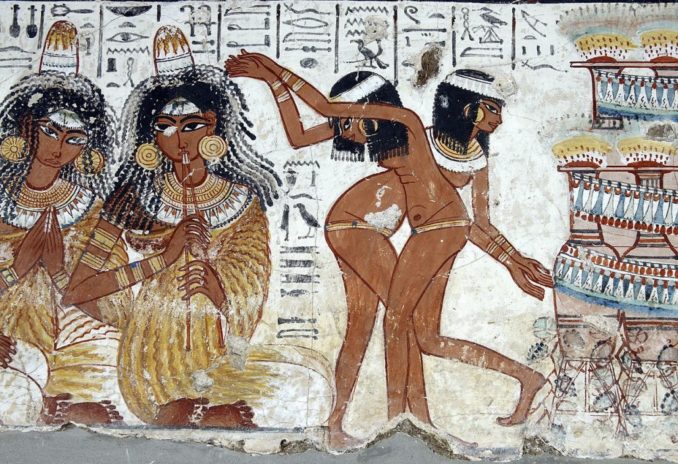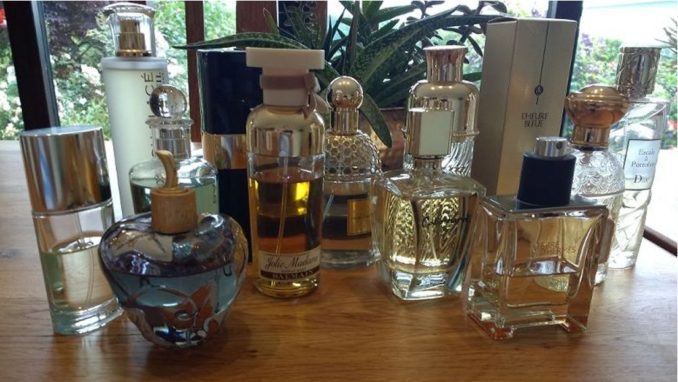Even before I became obsessed with plants, I was fascinated by perfumes. As a small child, working on the premise that more is more, I remember mixing several bottles of my mother’s precious scents into one big bowl before proudly presenting it to her. To her credit, she didn’t lock me in the coal cellar on bread and water for a week (what I would have done), she just dabbed a bit of the now noxious concoction behind each ear and locked the few remaining bottles in the bathroom cabinet.
From earliest times, people have had an ongoing relationship with pleasant smells, whether as a means of covering up the less pleasant smells in their vicinity, as an aid to healing or religious worship, or as an invitation to vice romance. The Egyptians, for instance, used to place cones of scented wax and resin on their elaborate wigs, so that their body heat would gradually melt them, scenting their skin and creating an almighty mess for the servants to get out of their clothing and hairpieces afterwards.

British Museum, Public domain, via Wikimedia Commons
Until the beginning of modern perfume creation, at the end of the c19th, perfumery was limited to the extraction of natural essences, occasionally mixed with exotic resins and spices, or animal substances like civet or ambergris. Whether extracted by distillation or by infusing in alcohol or vinegar, the scents that men and women wore did not vary that much over the centuries. Where perfume really came into its own was the twentieth century, when it changed from being a rather humdrum craft into an art form, created by perfumers who were a cross between alchemists, drug-crazed obsessives, and olfactory geniuses.
Most of the truly great classic perfumes were created at this time. I’m not talking about the powerhouse scents of the 80s and 90s, which could clear a building more quickly than pepper spray and at half the price, nor the ghastly synthetic sickly-sweet concoctions that arrived thereafter and are still with us. Some of the best are listed here, in this definition of the scent categories which evolved at this period:
Single Floral: Fragrances dominated by a particular flower; called a soliflore. Example: Fath Iris Gris.)
Floral Bouquet: Compound of several flower scents. Examples: Houbigant Quelques Fleurs, Jean Patou Joy.
Amber or Oriental: Large class featuring sweet, slightly animalic scents of ambergris or labdanum often combined with vanilla, tonka bean, flowers and woods. Can be enhanced by camphorous oils and incense resins. Examples: Guerlain Shalimar, Yves St Laurent Opium.
Woody: Fragrances dominated by woody scents, typically agarwood, sandalwood, cedarwood, and vetiver. Patchouli is commonly found in these perfumes. Examples: Myrurgia Maderas De Oriente, Chanel Bois des Îles, Balenciaga Le Dix.
Leather: A family of fragrances featuring honey, tobacco, wood and wood-resin in the middle or base notes in a scent that alludes to leather. Traditional examples: Piguet Bandit, Balmain Jolie Madame.
Chypre: This includes fragrances built on bergamot, oakmoss, and labdanum. Traditional example: Coty Chypre. Modern example: Guerlain Mitsouko.
Fougere: Built on a base of lavender, coumarin and oakmoss, with a sharp herbaceous and woody scent. Many men’s fragrances belong to this family. Examples: Faberge Brut, Laroche Drakkar Noir, Penhaligon Douro.
As for my own collection, I used to have about 50 bottles of carefully collected ‘greats’, most no longer available in their original format after the EU Scientific Committee on Health and Environmental Risk and the International Fragrance Association declared many natural substances used in perfumery to be verboten (may they roast in Hell for an eternity). I’m down to about 30 now – no point in having perfumes if you don’t enjoy wearing them. If I had to choose a favourite, it would be Balmain’s ‘Jolie Madame’.

© Madam Revenant, Going Postal 2021
Some vintage perfumes sell for substantial prices. If any of you come across Fath’s ‘Iris Gris’ on your mother’s or grandma’s dressing table, encourage her to sell it. Made of refined and costly essences and often described as the greatest example of the perfumer’s art, last produced in 1954, it very rarely comes up for sale. Last time I saw some a few years ago, a tiny 10ml unopened bottle sold for just shy of £1000. You could practically name your own price these days.
© Madam Revenant 2021
The Goodnight Vienna Audio file
Audio Player



